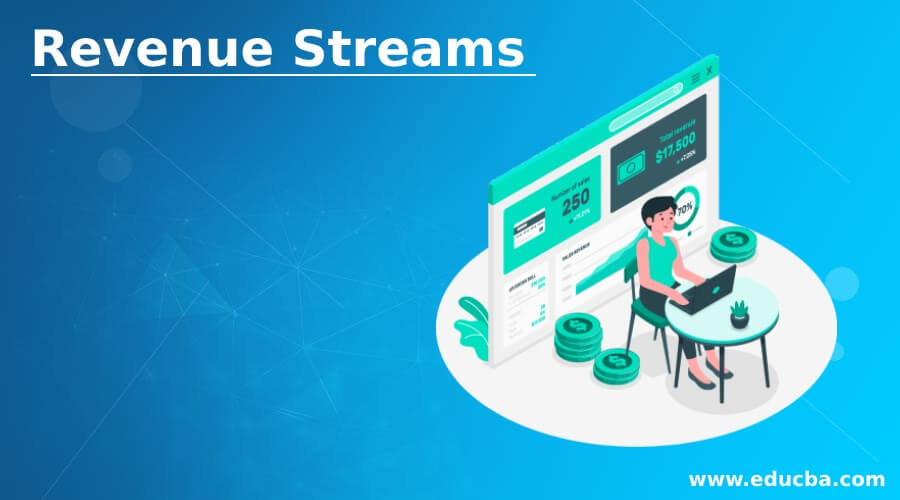Updated July 5, 2023
Definition of Revenue Streams
Revenue streams are the sources of revenues or incomes for a company or a business, including projects, sales of services and products, revenues from financing or recurring revenues, etc.
Explanation
Companies obtain revenues, sales, and profits by generating money by exploring various revenue streams. Like many small streams of water bodies form a big river, bigger revenues are formed by combining one or smaller revenue streams. That said, the classification can vary from one business to another.
Examples of Revenue Streams
- Goods and services revenues
- Interest revenues
- Lease or rent revenues
- Dividend revenues
- Revenues from capital gains, pay-offs, etc
- Revenues from selloffs and divestitures
A good example in this context is the search-engine giant Google which earns more than 80% of Alphabet’s revenues through selling advertisement spaces. Facebook observes a similar revenue stream classification.
In the last fiscal 2019, Roper Technologies, Inc. announced the sale of its Gatan business to Ametek, Inc. for $925mn, in an all-cash deal. The revenue income earned by Roper Technologies, Inc. from this divestiture will be recorded as a one-off revenue income. It is always important to note the treatment of such transactions in the company’s financial statements to understand the revenue streams.
Types of Revenue Streams
- Products- and Services-Based Revenues: In their normal course of business, companies earn revenues from selling products or providing services to the customers
- Project Revenues: Companies that engage in one-off projects or contracts often earn revenues that do not have recurring nature and may only be a one-time transaction
- Recurring Revenue: Revenues earned multiple times over specific periods due to repetitive providing of services and sale of products. Such revenues include rental revenues, advertisement revenues, subscription sales, etc
- Transaction-Based Revenues: Revenues that are earned when a transaction occurs, and usually one that demands specific efforts to attract a transaction. For example, a furniture sale can lure customers into buying good sofas at cheaper prices, earning transaction-based revenues.
Importance
The knowledge of revenue streams is important for businesses because it helps in understanding the nature of revenues, the cyclicality and predictability around the revenues, and the assessment and analysis of how to increase or stabilize the revenues for the business.
Take, for example, an e-commerce business that sells its customers books and office supplies. The annual revenues are somewhere between $100,000 and $120,000. The team wants to know what part of the revenues was generated by selling books, office supplies, and advertisement spaces. The team will utilize the concept to tackle this problem. It may come up with two streams – product sales (95-96%) and advertisement (5-4%), that make up total sales for the business.
Revenue streams are as important to know as revenues themselves. Companies prepare strategies going forward based on revenues and find it extremely helpful in estimation. It segregates revenue earned or recognized, efficiently deploying resources to improve business income.
Advantages
- Foremostly, it is the elixir of any business. The more revenue streams, the more diversified the business and the less risky it is to market volatility. Imagine company A that get revenues from product sale, and company B gets revenues from selling products, ads, and taking projects from other than regular customers. Company B has more diversity and hence better prospects in economic depredation.
- It helps to predict and estimate the business’s sales and revenues. When revenues are difficult to forecast due to seasonality or volatile market conditions, it gives better insights by deep diving into the end markets or coming as close to end users as possible.
- Company management can associate the key performance indicators and the Key result areas with the segmented revenue streams to create orderly revenue management.
- Some businesses, especially conglomerates, have more than 5 or 6 revenue streams. Estimating business revenues using a common methodology or parameters may be unreliable and lead to discrepancies. Large businesses allocate different models, sales predictions, or pro forma statements to different revenue streams in such circumstances.
Disadvantages
- It can create a mess if not properly addressed and vaguely managed. If the company selling books does not have expertise in managing the revenues from advertisements, it is useless to allocate costs to manage unproductive revenue streams.
- It can be an important factor for investors while valuing businesses as they place the utmost importance on revenues whilst forecasting business growth. Any weaknesses or volatility in it can seriously hurt investor confidence.
- Any analysis and management around revenue streams can attract huge costs as businesses need to identify markets, the nature of revenues, adjust for cyclicity, etc.
Conclusion
Revenue streams are an important function of the business model canvass companies use to strengthen growth and stability. A business canvas is based on 9 elements viz. Partners, activities, costs, value proposition, resources, customer segments, channels, and revenue streams. It defines as how a business converts value propositions into financial or economic gains by addressing customer needs.
Companies usually identify with 3 major revenue streams i.e. product- or service-based revenues, finance income revenues, and revenues from one-off events. There can be various other streams through which revenues can be earned. Businesses in the e-commerce and internet spaces have subscription-based models to generate revenue streams. Manufacturing businesses manage it through product-based earnings. Online businesses have blossomed by collecting revenues through advertisement fees.
Recommended Articles
This is a guide to the topic. Here we also discuss the definition and examples of revenue streams and their advantages and disadvantages. You may also have a look at the following articles to learn more –


